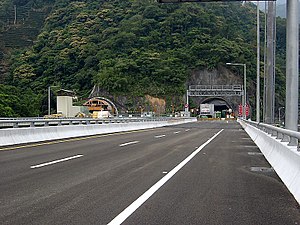|
Hsuehshan Tunnel
The Hsuehshan Tunnel (Chinese: 雪山隧道; pinyin: Xuěshān Suìdào) is the longest tunnel in Taiwan, located on the National Freeway 5. It opened on June 16, 2006. OverviewThe tunnels are bored through the Hsuehshan Range. The road connects Taipei through New Taipei to Yilan County,[1] cutting down the journey time from two hours to just half an hour.[2] It bypasses the rural district of Pinglin, which used to receive high traffic prior to the completion of the tunnel. One of the key aims of constructing the tunnel was to connect the western coast of Taiwan, where 95% of the population lives, to the eastern coast of the island and in doing so tackle the unbalanced development on the island.[1] It is constructed with one pilot tunnel and two main tunnels for eastbound and westbound traffic. The total length is 12.942 km (8.042 mi), making the Hsuehshan Tunnel the ninth longest road tunnel in the world (fifth at the time of opening) and sixth longest in East Asia. The tunnel opened in June 2006 to severe traffic jams.[3] Tunnel ConstructionTunnel construction began in July 1991 and took 15 years to complete and cost a total of NT$90.6 billion (US$2.83 billion).[4][5] Tunnel construction used 370,000 m3 (13,000,000 cu ft) of concrete, 2,000 kilometers (1,200 mi) of cables, and 2,000 lighting units.[5] While excavating the tunnel, engineers encountered difficult geological problems such as fractured rock and massive inflows of water, which caused severe delays. One of the three TBMs on the westbound tunnel was buried by a ground collapse. In order to speed up the tunnel boring, an additional working interface in Interchange Station No. 2 (under Ventilation Shaft No. 2) was built. Along the tunnel alignment, there are six major faults, ninety-eight fracture zones, and thirty six high-pressure groundwater sources. Hence, serious tunnel collapses with groundwater flooding took place periodically during tunnel construction. Altogether, 25 people died during 15 years of construction.[6] OperationsWhen traveling through the Hsuehshan Tunnel, vehicles must not exceed the 90 km/h (56 mph) limit; otherwise the drivers face a NT$3,000 (US$93.75) to NT$6,000 (US$187.5) fine.[7] The usual minimum speed limit is 70 km/h. Additionally vehicles must maintain a separation distance of 50 m (164 ft) under normal situations. Even when the speed is less than 20 km/h (12 mph) due to congestion, a separation distance of 20 m (66 ft) must still be maintained.[8] Double solid lines prohibit lane changes. Automated road-rule enforcement cameras are used to monitor speeders, tailgaters, and those who unlawfully change lanes. Announcements of zero tolerance of speeding meant that those traveling at 71 km/h would be fined. After creating controversies,[9] effective 00:00 (UTC+8) on September 16, 2006, a tolerance of 10 km/h has been allowed so speeds up to 80 km/h are no longer automatically penalized.[10] As of Nov 1, 2010, the speed limit was raised to 90 km/h to allievate traffic.[11]  Tunnel information
See alsoReferences
External linksWikimedia Commons has media related to Hsuehshan Tunnel. |
||||||||||||||||||||||||||||||||||||||||||||||||||||
Portal di Ensiklopedia Dunia
